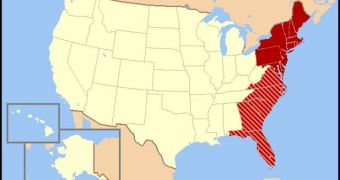A new scientific study, published in this week's issue of the respected journal Proceedings of the National Academy of Sciences (PNAS), outlines the best sites on the East Coast of the United States to store carbon dioxide (CO2). Researchers say that the buried volcanic rocks that exist under New York, New Jersey and New England have a composition that makes them ideal sponges to soak up the dangerous chemical. The team behind the new paper even lists a series of locations where soak-up sites may be constructed, PhysOrg reports.
Fossil-fuel power plants, vehicles, industrial areas and other human activities produce very large amounts of pollution, and one of their main byproducts is carbon dioxide. The United States is, at this point, the second largest polluter in the world, after China. Therefore, a method of reducing the impact that its CO2 levels cause on the environment is welcomed, experts say. Volcanic rocks are known to be extremely apt at soaking up CO2. In fact, they are so good that, at one point in the Earth's history, they sucked sufficient amounts of the stuff from the atmosphere to cause a global ice age.
Previous plans at CO2 sequestration targeted limestone or shale, a type of sedimentary rock. But they all raised concerns about spills, and also cost-related issues. The newly proposed method targets the basaltic rock, which researchers say is more apt at soaking up the chemical for several reasons. Research has shown that carbon injected in this rock tends to undergo a series of natural reactions that eventually see it transforming into a mineral similar to limestone. The basaltic rock spreads from Manhattan to New Jersey, and all the way to Connecticut, experts say. The only challenge ahead is to make the natural mineralization process run at a large scale, scientists believe.
Basaltic deposits also exist underwater, in large patches off New Jersey, Long Island and Massachusetts. “We would need to drill them to see where we're at. But we could potentially do deep burial here. The coast makes sense. That's where people are. That's where power plants are needed. And by going offshore, you can reduce risks,” geophysicist David S. Goldberg explains. He is a professor at the Columbia University Earth Institute, and also one of the authors of the new study. “The basalt itself is very reactive, and in the end, you make limestone. It's the ultimate repository,” Rutgers University researcher Dennis Kent, a coauthor of the PNAS paper, says.

 14 DAY TRIAL //
14 DAY TRIAL //